In This Issue:
By Vincent Lecca, TPWD Area Chief, and TPWD Staff
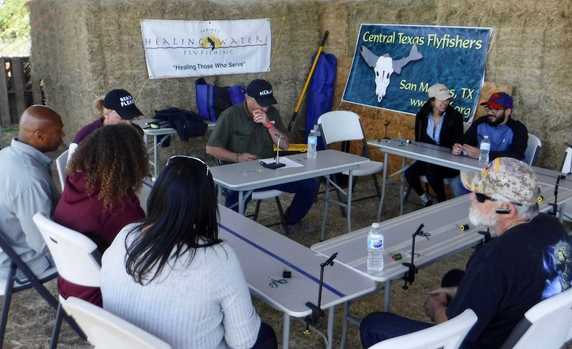 Image: PHWFF - San Marcos chapter fly tying group. Photo courtesy of Vincent Lecca.
Project Healing Waters Fly Fishing (PHWFF) began in 2005 serving wounded military service members at Walter Reed Army Medical Center who were returning from combat in Iraq and Afghanistan. Since then, PHWFF has expanded nationwide, establishing its highly successful program in Department of Defense hospitals, Warrior Transition Units, and Veterans Affairs Medical Centers and clinics. Programs rely on Fly Fishers International (FFI), Trout Unlimited (TU), and independent fly fishing clubs to conduct the programs.
Project Healing Waters brings a high-quality, full-spectrum fly fishing program to an ever-expanding number of disabled active military service personnel. We focus our resources wherever the need is greatest and expand our partner base in the process. PHWFF has become recognized as an innovative leader and model in the field of therapeutic outdoor recreation for the disabled, through its successful application of the sport of fly fishing as a rehabilitation tool. There are seven programs in the PHWFF South Central region across the state! Check out the link for a program near you. Information about each chapter’s activities and a contact is listed below if you want to participate or volunteer.
At Texas State University in San Marcos, there are 1,300 student veterans who are being supported by this program, and volunteers like myself have been helping over the past two years as a fly fishing Coach. The San Antonio and San Marcos programs held their first fly tying session at Audie Murphy VA Hospital in the fall of 2014, and held their first fishing trip in 2015. The San Marcos group now has over 300 disabled veterans participating in the program. They held their first appreciation dinner in April 2018, over one hundred folks attended to salute our troops, it was a huge success. Anyone who enjoys fly fishing is encouraged to come out and join in. For more details contact Vincent Lecca: Vincentlecca@yahoo.com.
The San Antonio program activities are still largely centered on clinics at the Audie L. Murphy VA Hospital and the Center for the Intrepid at Ft. Sam Houston. Participants not associated with any particular clinic are welcome to join fly tying sessions at the VA Hospital Recreation Room every other Wednesday afternoon or every Tuesday evening with our sponsoring club, the Alamo Fly Fishers at the Alamo Heights Presbyterian Church. Currently, only one major fishing event is held annually but other outings to the Texas Hill Country rivers occur when the alignment of weather, access to water, and personal time present an opportunity. For more details contact Program Lead Dave Gill: dave.gill@projecthealingwaters.org .
The Conroe chapter recently started a PHWFF activity with the Conroe VA. Up to this point they have been having introductory activities. They will start their casting, and fly tying activity shortly and then rod building and local fishing events. As they have moved ahead they have gained more participants. The volunteers consist of people from Houston, the Woodlands, and the Conroe area. They are looking forward to more participants. Contact program lead Bill Huegel: txfritz4134@suddenlink.net
In north Texas, fishing events are held in the spring and fall each year in the Lake Fork area and near Cumby, TX. A ladies-only event is also hosted. Fly tying classes are held every Wednesday from 11:00 AM to 12:30 PM at the Fort Worth VA Outpatient clinic; and on Tuesdays from Noon to 2:00 PM at the VA in Dallas. They are looking for an additional tying class to start soon in the Plano area as well as casting clinics and rod building classes. For more details contact program lead Johnny Walker: Johnny.Walker@projecthealingwaters.org.
The Fort Hood PHWFF chapter holds fly tying classes at two locations, 4 times a month at Fire Station #8 in Killeen, and at the Georgetown VFW. They also take fishing trips as often as possible and fish a lot of private ranch lakes and central Texas lakes, including Whitney, Buchanan, and Belton in addition to other extended trips. For more details, contact the program lead Bill Adams: billadams1957@gmail.com or (254) 386-6170.
In East Texas, the Lufkin Program meets every other Friday at the local VA Clinic at 2:00 PM. They are in their 8th year. Their program lead, Walter McLendon can be reached at wem@usa.com.
Walter shared one participant's heartfelt note about the program that probably sums it up for all involved in PHWFF program: “These classes have been so good for me, they have helped me so much – both my physical and mental well-being. One year ago I did not even talk to anyone, I would come to the class sit and not even smile, time to leave I was gone. You guys kept coming and coming, and now I talk and joke. I now feel I have a purpose, that someone cares. If you only knew where I was at, then you could understand. I will always be grateful for you and the club. Thanks from the depth of my heart.”
Back to Top
by Cheryl Boll, Griffin Elementary PE Teacher, Tyler ISD and TPWD Certified Angler Education Instructor
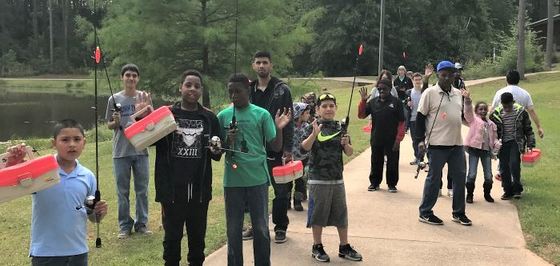
In 2017 I took the TPWD Angler Education Instructor certification workshop. I have always wanted to have a fishing club at the school where I teach. I am a physical education teacher at Griffin Elementary in Tyler. As a child I loved the sport of fishing and wanted to give my students the same experience. Keira Quam, TPWD Training Specialist, got me in contact with Michael Scherer, TPWD Area Chief who also works with Fishing’s Future. He was gracious enough to give me equipment to get started.
We held our First Catch Center event at the Glass Recreation Center in Tyler and everyone had so much fun. From there, I started a fishing club at my school. We meet every Wednesday for two hours after school and the kids and parents love it. I called the program, “Let’s fish.” Our club got started at the end of the school year but we were able to start with lessons on safety and casting for backyard bass during our meetings. I even had a station at our field day. By the end of the year, I had about twenty kids wanting to sign up. I will definitely continue next year!
I have had parents tell me that all their child wants to do now is fish. I even had one guy that wanted to have fishing for his birthday theme! This next year I would love to have an event for the kids to camp out overnight and also go fishing. I appreciate the support from TPWD, Keira and Michael for making a dream come true.
Program Note:
Recreational Boating and Fishing Foundation (RBFF) created a Sixty in Sixty national campaign in 2016 to recruit 60 million anglers in 60 months. The overall objective is to grow national participation in the sport of fishing.
RBFF and Fishing’s Future have collaborated to set up multiple “First Catch Center” fishing events in Texas to provide a positive and fun fishing experience for families and youth. Angler Education Volunteers support the free events and help teach basic fishing skills, knot-tying, fishing regulations, fish ID and habitat, angler ethics, proper fish handling techniques, water and boat safety, environmental stewardship, and shoreline fishing. Fishing’s Future provides equipment and bait, or families can bring their own gear. Class registration is limited to give families a quality experience and create lifelong anglers and boaters, who in turn conserve our natural resources for current and future generations through the purchase of equipment and fishing licenses.
Sign-up online to volunteer at an event, use the keyword search First Catch Center.
|
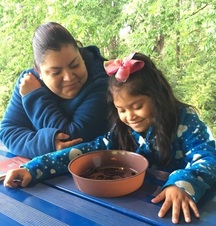 Photo by Cheryl Bolls
Back to Top
By Karen Marks, TPWD Aquatic Education Manager
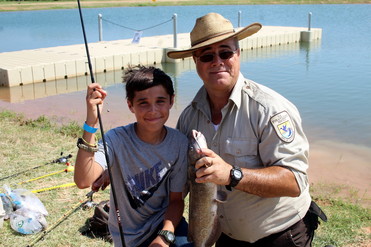 It has been a busy spring for all and we are delighted to fully staffed once again.
FREE FISHING DAY
Volunteers and staff hosted several fishing events across the state for the annual Free Fishing Day – the 1st Saturday in June in Texas. If you missed the opportunity in June, be sure to start planning your event now for the National Hunting and Fishing Day on September 22, 2018. Our Fishing Event Planning Guide is available online on the Instructor Resources webpage; it offers a helpful timeline and checklist to make your event a great success. If the event is free and open to the public, we can advertise it on the TPWD Events Calendar. TPWD has also been supporting multiple First Catch Center fishing events hosted by Fishing’s Future and sponsored by the Recreational Boating and Fishing Foundation, look for an event near you and sign up to help -- use the keyword, "First Catch Center".
Image: Lots of fish were caught at the Free Fishing Day event held at the USFWS Inks Dam Fish Hatchery. Photo courtesy of Luedecke Photography
PROUD PARTNERS
Did you know a TPWD Proud Partner Logo is available for Certified Instructors to use on event fliers and banners? The Texas Parks and Wildlife Department logo has long been a well-recognized symbol of the agency. In order to maintain the distinction between agency and partner groups, we ask that instructors use the TPWD Proud Partner Logo. To request the logo file, download the Proud Partner agreement from the Instructors Resource webpage, complete the agreement and send it to the email address on the form and cc me at Karen.Marks@tpwd.texas.gov Upon approval, the logo file and print guidelines will be sent to you.
Note: If you forgot the password for the Instructors Resource web page, look in your Instructor Guide notebook - see chapter VII, or contact us.
|
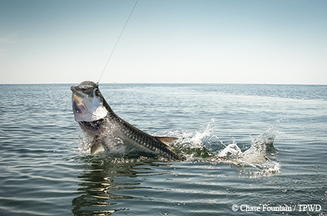 REPORTS MAKE A BIG SPLASH
During the first three quarters of our fiscal year, which ends August 30th, we received 2,000 reports from 450 volunteers -- 60% of them were submitted online!
We love to get the online reports! They are also more likely to pass the auditor's review. However, we realize that sometimes a paper roster is necessary if the 45-day deadline was missed or if you need to capture the hours for your volunteer helpers. Just remember that if you submit a volunteer roster for your assistants, use one roster per day, and each volunteer must "self-report" on the form - this means each individual must print, sign and list their hours. Per the federal guidelines, the class/event leader may not sign for or write in the number of hours for other volunteers.
Another common error we see on the reports, is a lump sum of hours for multiple days. Remember that your hours must be itemized by day – you can do this in the notes section of the online report. If you need to document time for multiple days, use the new Instructor Timesheet Tracker form on the Angler Ed Instructor Resources web page under the Order and Reporting Forms section.
If we receive an incorrect report, we will attempt to contact the instructor to correct the report and verify their hours so we can include them on the annual federal aid grant report for the $24/hour match.
Documentation of your fishing classes and events are vital to the success of our program. View the Reporting Guidelines to ensure your reports meet the policy. Whether you lead or assist at an event or class, reporting online is easy. You can use a computer, smart phone or tablet that has an internet connection. If you have any questions, please feel free to contact us.
Keep up the great work and help us make a BIG SPLASH (like a Tarpon) on our year-end report!
|
Back to Top
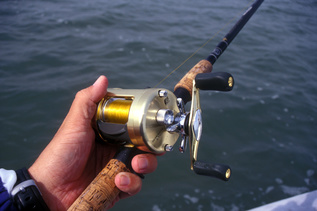 By Ryan Cash, TPWD Area Chief
Modern fishing reels have become a sophisticated machine of gears,
bearings, springs, clips, and washers that are all equally important to
the function of the reel. Routine care of fishing rods and reels is crucial to maintain their function and improves the angler's success.To clean and maintain a reel, first become familiar with the parts of a reel.
|
EXTERIOR MAINTENANCE
A routine
examination of the outside of the reel is just as important as the
inside of the reel. First, make sure that the outside is clean of any
dirt, sand or salt, and there are no noticeable signs of corrosion or
damage. For a bait-casting reel, make sure the handle, spool, and line
guide system turn properly. Also check to ensure that the thumb bar will
engage and function as it should and that the drag will loosen and
tighten as well. The same checks and evaluations will apply to spinning
reels.
Any moving parts on the outside of either style of reel will
require a periodic application of oil or grease. When lubricating the outside
of any reel use a lubricant
recommended by the reel manufacturer or a high-quality silicone-based
lubricant. Avoid using any
oil-based products as they tend to be attractants for dirt and debris, and do not last as long or lubricate as well because they
do not mix well with water and break down faster. It is important to remember that friction is the enemy of
all moving parts, but that proper lubricating of moving parts can
greatly reduce the damaging effects caused by friction.
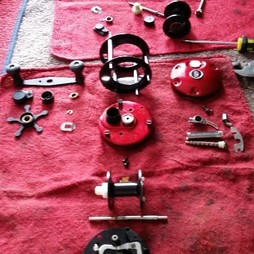 INTERIOR MAINTENANCE
Cleaning
and maintaining the inside of a reel is a little more challenging
than the outside. While not impossible to do, taking apart the inside of
a fishing reel requires close attention to where
each and every part goes. Some helpful hints before you start:
1) Use a cell phone or a
digital camera to take pictures of how it looked before removing
anything.
2) Search the internet for a schematic or parts
diagram and print it for reference. Almost every reel
has a schematic or parts diagram available either through the
manufacturer’s website or through a handful of online resources. Some
reels when purchased new will come with a schematic or parts diagram.
When you are ready to disassemble your reel, begin with a towel on the table and gather your tools:
- a couple of different sized screwdrivers, both flat-head and phillips-head
- a pair of pliers or a small adjustable wrench
- reel oil and reel grease.
|
When disassembling the reel, remove each part and lay it on the towel in
the order and direction with which it was removed. Place each
part in a line from left to right, then it will be easy to reassemble
the reel by simply starting from the right side and moving left.
Wash each part of the reel with soap and water and allow everything to dry well before reassembling. I like to use an old toothbrush and really scrub each part. Washing each part with soap and water helps to remove any dirt, sand, salt, or old oil and grease. After all parts have been thoroughly cleaned, apply either grease, oil, or both to all moving parts of the reel. It is important to remember that, while it may seem backwards, when applying oil or grease, less is more. Over use of grease can potentially harm the reel or at least greatly reduce its performance. Check the manufacturer’s website for more information and lubrication recommendations. Penn, for example, has a service section on their website that includes the manual and tips for recommended reel care.
Most recreational anglers should thoroughly clean their reels at least once a year. Saltwater anglers need to rinse their reels with freshwater and apply a light coating of oil after every trip to reduce corrosion and rust, and prolong
the life of the reel.
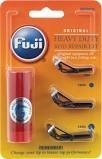 ROD CARE AND ROD TIP REPLACEMENT
Fishing rod maintenance is not as difficult or intensive as reel repair, but there are a few things to remember. After fishing, rinse any dirt, mud, sand, or salt from the rod. Allow it to dry, then take a rag and wipe the rod down with reel oil or a silicone spray. Check for any lose or damaged rod guides. Car doors, truck tailgates, and ceiling fans can be particularly tough on rod tips. If the rod tip gets broken, it can be replaced with these simple steps:
STEP 1: Purchase a rod tip repair kit from an outdoor retailer. The kit will include three popular sizes of rod tips and a glue stick. Select the rod tip that fits your rod best. The replacement tip should fit snug. Remove the damaged rod tip if it is still attached by heating the metal base of the guide with a lighter. This will melt the glue and loosen it. Use a pair of pliers to hold on to the tip as it could be hot from the heating process.
|
STEP 2: Next, attach the new rod tip. Use a knife or razor blade to cut a sliver of adhesive. Insert the adhesive into the rod tip tube, and then apply heat with a lighter. Twist the tip onto the rod end; make sure it is aligned with the other guides. Wipe off any excess adhesive.
Check the internet or YouTube for more DIY info, or take your gear to a reputable repair or service shop. Either way, properly caring for your rods and reels will ensure that they will last for many years.
Images: Baitcast fishing reel. Photo by TPWD (top); reel parts (middle) and rod tip repair kit (bottom) photos by Ryan Cash
Back to Top
By Karen Marks, TPWD Aquatic Education Manager

As summer begins, we enter the 4th quarter of our fiscal year that
ends on August 31st. Those of you that have been around for awhile know that means
it’s time to get your reports in. But just as important, we want everyone to stay
safe outside when conducting fishing classes, events or camps this summer.
Image: Storm clouds roll in at Cedar Hill State Park. Photo by TPWD.
Thunderstorms,
lightning, hail and flash floods
can pop up during the summer – so be sure to check the weather forecasts and
apps for alerts, and have a safety plan in mind. During a weather incident, retreat to a nearby building for safety, vehicles are a good
alternative. NOAA recommends waiting 30 minutes after hearing the last thunder
before going back outside (where there is thunder, there is lightning.) As I
write this, I remember a Girl Scout Brownie troop campout where we had half the girls in
the bathroom and the other half crammed into the Suburban during an expected
afternoon thunderstorm.
Heat stress is another factor to consider. Make sure
everyone (participants and volunteers) drink plenty of water. To stay cool on
these dog days of summer, wear a hat and a wet neck towel or bandana, provide shade, and
set up a buddy system to watch each other for signs of heat stress. OSHA has a
great Heat
Safety app that is free to download on your smart phone. The app has heat
stress symptoms, first aid recommendations; and uses your location to predict
the hourly heat
index for the day (low, moderate & high risk). Use the heat index information
to make adjustments to the class or event schedule as needed to keep everyone
safe. Consider scheduling events in the morning to avoid the hot afternoons. If event is all day, plan outdoor activities in the morning and indoor
activities in the afternoon.
No matter the size of the event, it is important to
keep patrons and staff safe. For example, event coordinators made a wise
decision to close the day-long Abilene Outdoors Adventure Days event early due
to the rising heat index. At the Toyota Bassmaster Texas Fest, staff and
volunteers had to make a hasty retreat to vehicles during an unexpected thunderstorm.
To keep our waterways safe for people and wildlife, our program has
re-usable mesh litter bags available for anyone planning a clean-up. Angler
Education Instructors who have been actively reporting, can order up to 12 free
bags while supplies last. Email education@tpwd.texas.gov
with the subject line, “Angler Education Litter Bags,” include in the email the quantity
request, along with your name, shipping address and phone number. Remember –
these are re-usable bags, so don’t throw them away at the end of your clean up –
empty, rinse and reuse them. And don't forget to report your clean-up event. For additional resources, webinars and lessons
about litter, check out EPA’s
Trash-Free Waters Program and NOAA’s
Marine Debris Program. We also have a link on the “Teach Fishing” webpage on
how to build and monitor a fishing
line recycling tube. Everyone can make a difference. Thanks for supporting the sport!
Back to Top
|
Welcome new instructors and congratulations to our Area Chiefs (volunteer Train-the Trainers) who earned their Bronze, Silver, Gold
and Platinum awards! Staff and Area Chiefs trained 324 new instructors from January to June 2018.
AREA CHIEFS GO COASTAL!
We
hosted our annual Angler Education Area Chief (Train-the-Trainer)
meeting at Quintana Beach County Park in March. We are grateful to Area
Chief Mike Mullenweg and his supervisor Bryan Frazier with Brazoria
County Parks who provided the wonderful meeting facilities. We kicked
off the weekend with fishing and a tour of Sea Center Texas on Friday. A
full day of training on Saturday included an overview of the Outdoor
Recreation Adoption Model and Angler Recruitment, Retention and Reactivation (R3) with Johnnie Smith, Education and Outreach Director.
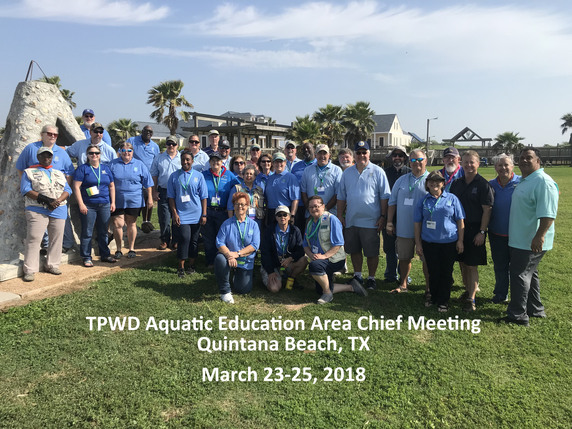
 Area
Chiefs worked in small teams to discuss best practices for workshop planning and presented
how to teach different fishing skills.
They revealed their true
creativity during the Aquatic WILD “Fashion a Fish” activity and tested
their reflexes with a “Set the Hook” activity using a 12-inch ruler.
Image: Area Chiefs Jael and Chad try out the "Set the Hook" activity.
Saturday afternoon, staff
prepared a fish fry dinner while
everyone went on a guided historical walking tour of the park. During dinner, we had a Game Warden Q&A
session with Captain Eric Minter. Later in the evening, a small group
practiced tying flies.
On Sunday, we learned about the new Explore Bowfishing program,
and how to throw a cast net. Twenty-seven people from Abilene, Central
Texas, DFW, El Paso, and the Houston region attended the training
meeting, including 13 new Area Chiefs. Annual awards were presented to
Area Chiefs for their leadership and dedication to our Instructor
training program. If you are interested in becoming an Area Chief and
training new instructors, please contact us.
Back to Top
|
Check out our TPWD resources to learn more about Texas fishing!
Angler Education Program | Texas Angler Educators Facebook
Learn to Fish Videos | Texas Aquatic Science | TPWD Fishing Information
Volunteer Portal | In Memoriam | Staff Contacts
Back to Top
Angler Education Instructor Workshops, Fishing Events, Fly Fishing Events, Texas Freshwater Fisheries Center, Sea Center Texas
Back to Top

|